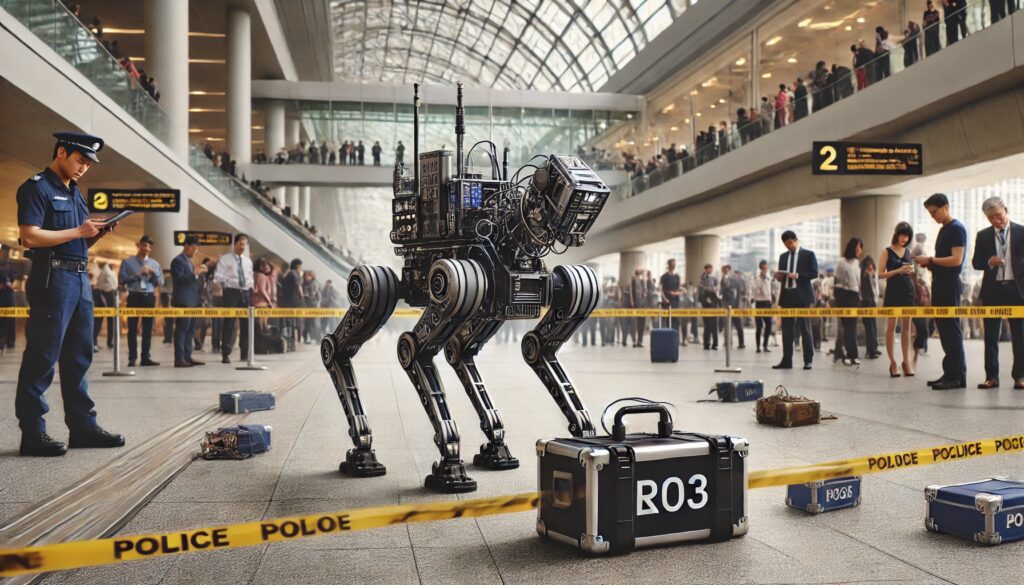Artificial Intelligence (AI) is reshaping the landscape of modern warfare, introducing capabilities that were once the realm of science fiction. In military operations, AI is poised to enhance decision-making processes, automate repetitive tasks, and provide new tools for defense and attack.
The use of AI has the potential to revolutionize various aspects of combat, from strategic planning to the execution of complex missions. With nations around the globe investing heavily in AI research and development for military applications, it is becoming clear that AI will be a defining factor in future conflicts.

The integration of AI into military systems ranges from missile defenses to cyber operations, affecting everything from logistics to battlefield tactics. It promises improved efficiency in target identification, surveillance, and reconnaissance, while also raising challenging ethical and strategic questions about the role of human oversight in autonomous systems.
As AI evolves, it is crucial for policymakers and military strategists to understand its implications for nuclear warfare and the maintenance of international peace and security.
Nevertheless, the deployment of AI in warfare comes with real risks and vulnerabilities. The reliability of AI systems under the stress of combat, the threat of adversarial machine learning techniques such as data poisoning and model evasion, and the broader strategic stability consequences are concerns that need meticulous examination.
Recognizing the significance of AI’s influence on warfare, the Department of Defense has released an AI adoption strategy aiming to maintain U.S. superiority in this field while navigating the complex landscape of emerging technology in the theater of war.
Historical Context of AI in Military Operations

The inception of Artificial Intelligence (AI) in the military can be traced back to the Cold War when strategic advancements were greatly prioritized. The potential of AI to offer strategic advantages saw earlier applications focusing on simulations and war-games designed to predict enemy behavior and optimize resource deployment.
- Simulations: AI-enabled simulations allowed for more dynamic modeling of conflict scenarios than previously possible.
- Strategy Optimization: Algorithms sought to improve decision-making in logistics, reconnaissance, and allocation of forces.
With technological progress, AI began to assume a critical role in intelligence analysis, through processing vast amounts of data to identify threats and opportunities. Machine learning advancements enabled the creation of predictive systems, necessary for swift decision-making in volatile environments.
- Data Processing: Swift analysis of satellite imagery and communications intercepts.
- Predictive Systems: Machine learning used for anticipating enemy movements and strategies.
The transformation of AI in military contexts has been continual. Initially enhancing conventional aspects of warfare, such as intelligence and strategy, AI’s role has since expanded into direct combat applications with the advent of autonomous drones and intelligent weapon systems. The groundwork has been laid, with various countries investing heavily in AI to maintain strategic advantages.
- Autonomous Drones: They can perform reconnaissance missions without direct human control.
- Intelligent Weapon Systems: AI algorithms to provide precision targeting and engagement decisions.
Given its ability to integrate and analyze information at unprecedented speeds and accuracy, AI is positioned to revolutionize military operations, underpinning future force capabilities and altering the tactical and strategic landscape. The use of AI in warfare suggests a pivot towards a more technologically driven form of engagement, where data and speed of response become as crucial as firepower.
Current State of AI in Warfare
The landscape of warfare is undergoing a significant transformation with the integration of Artificial Intelligence (AI). AI applications are currently shaping military operations with capabilities such as data analysis, surveillance, and unmanned systems. However, AI in its current form is not close to replicating the complex life control akin to human or animal cognition.
Military entities worldwide are employing AI to enhance decision-making through improved data analytics and situational awareness. AI-enabled systems streamline the processing of vast amounts of intelligence, allowing for rapid and informed decisions on the battlefield. The data-centric approach adopted by the Pentagon through its 2023 Data, Analytics, and Artificial Intelligence Adoption Strategy emphasizes the importance of AI in maintaining a competitive edge.
The use of AI in irregular warfare is evident, with artificial intelligence applications supporting counter-terrorism and insurgency operations. These systems, while advanced, lack the autonomy of decision-making that sentient beings possess. The concept of AI-led operations evokes debate, balancing the promise of efficiency with ethical concerns relating to autonomous weapons systems.
AI’s role in information warfare is also expanding, as shown in an analysis of its application within major power states for influence operations. Future developments are expected to focus on AI’s ability to not only collect but also analyze and act on information in real-time, as highlighted by emerging AI-powered, totally autonomous future of war.
While markedly transformative, AI in warfare today operates primarily as a sophisticated tool augmenting human capabilities, not replacing them.
AI-Driven Military Technologies

Incorporating advanced artificial intelligence into military capabilities is reshaping defense strategies. From enhancing decision-making to increasing the effectiveness of autonomous systems, AI is pivotal in modern warfare.
Autonomous Weapon Systems
Autonomous weapon systems engage targets without direct human intervention through programming. The Department of Defense has released a strategy to adopt AI technologies ensuring decision superiority. These systems range from drones capable of precision strikes to AI-guided missile defense systems. By reducing delays and increasing accuracy, they significantly uplift the combat effectiveness while attempting to minimize collateral damage.
Swarm Technology
Swarm technology, enabled by AI, refers to the use of numerous, small autonomous units that operate collectively. These swarms can be used for reconnaissance, jamming enemy communications, or overwhelming adversary defense systems. They mimic the complex behavior of natural swarms found in insects or birds, allowing them to be highly adaptable and difficult for enemies to counter.
Cyber Warfare AI
AI plays a key role in cyber warfare, where algorithms analyze vast amounts of data to detect and respond to threats more quickly than human operators could. Intelligent systems can predict potential security breaches and proactively neutralize them, safeguarding sensitive information and critical infrastructure from sophisticated cyber-attacks.
Ethical Considerations

The ethical landscape of AI in warfare is complex, particularly concerning life and death decision-making and adherence to international law. The integration of AI into military operations introduces nuanced challenges that require careful consideration.
Life and Death Decision-Making
The delegation of life and death decisions to AI systems is a contentious issue, raising significant moral and ethical questions. A poignant concern is whether society is comfortable with ceding such grave decisions to algorithms. In military applications, AI systems can identify and engage targets with less direct human oversight, which can potentially lead to reduced accountability and increased risk of errors with fatal consequences. Illustrating this are principles adopted by the Department of Defense, emphasizing that AI should be responsible, equitable, and traceable, reflecting a recognition of the gravity of the decisions made by these systems.
Regulations and International Law
AI’s use in warfare must align with existing regulations and international law. This includes compliance with humanitarian laws and the Geneva Conventions, which aim to limit the barbarity of war and protect the rights of non-combatants. Nations have contrasting positions on the development and regulation of autonomous weapons, with some advocating for a preemptive ban on fully autonomous systems capable of lethal force. Ethical considerations demand that AI-enabled weapons not only discern combatants from non-combatants but also evaluate the proportional response, a requirement pivotal to maintaining moral conduct in conflict and emphasized in research on AI’s ethical implications in warfare from Queen Mary University of London.
Artificial Intelligence and Strategy Formulation

In the realm of warfare, Artificial Intelligence (AI) is revolutionizing the way military strategies are formulated. By leveraging advanced algorithms and data processing, AI enables armed forces to make more informed decisions in the complex field of military engagements.
Predictive Analytics
Predictive analytics, powered by AI, allows military strategists to forecast potential threats and enemy movements with greater accuracy. By analyzing vast amounts of data, AI systems can identify patterns and correlations that might elude human analysts. For instance, the U.S. Department of Defense is bolstering its capabilities in AI to solidify the United States’ competitive edge by predicting adversarial actions before they occur.
AI in Tactical Planning
AI’s role in tactical planning is becoming increasingly critical. AI algorithms assist in creating dynamic battle plans that can adapt to changing conditions in real-time. They support the decision-making process by providing various scenarios and outcomes based on current intelligence. The integration of AI in tactical operations is a key element in maintaining a strategic advantage, as highlighted by the discussions on AI weapon systems in future war operations.
AI in Logistics and Support Systems

Artificial Intelligence (AI) is significantly enhancing the efficiency and resilience of military logistics, ensuring that forces are adequately equipped even in the most contested environments.
Supply Chain Automation
AI technologies are integral in streamlining supply chains, where predictive analytics play a crucial role in forecasting demands and managing inventory. An example is the U.S. Department of Defense’s initiative to employ AI for better resource allocation, where systems analyze vast amounts of data to anticipate material requirements precisely, thus optimizing the supply chain.
- Route Optimization: AI algorithms can analyze historical data and current conditions to choose the most efficient routes for transportation, avoiding potential threats and congestion.
- Automated Warehousing: The use of drones and automated vehicles within warehouses to manage inventory reduces human error and increases processing speed.
Maintenance and Repairs
Predictive Maintenance is a critical application of AI, where the technology assesses the condition of equipment to predict when maintenance should be performed. This proactive approach minimizes downtime and extends the life of military assets. The use of AI for maintenance and repairs results in:
- Diagnostic Accuracy: Enhanced error detection through AI algorithms leads to more accurate diagnostics, ensuring that the correct repairs are made.
- Resource Optimization: AI enables the military to prioritize maintenance tasks based on urgency and available resources, as reflected in the Future of Army Logistics, focusing on optimizing the decision-making process in asset management.
Impact on Military Personnel

In the evolving landscape of warfare, AI’s influence on military personnel centers on enhancing training protocols and amplifying battlefield capabilities. Discourse regarding the potential redundancy of human roles in pivotal decision-making processes is ongoing.
Training with AI
AI is revolutionizing the way military personnel are trained. Through advanced simulations and virtual reality environments, they are able to experience realistic combat scenarios, enabling them to hone their skills in a controlled, yet complex, setting. The United States Military Academy’s insight highlights that AI’s integration in training protocols provides both strategic and ethical challenges for countries like the United States, ensuring that warfighters adapt to the dynamic nature of modern combat without compromising ethical conduct.
AI as Force Multipliers
On the battlefield, AI acts as a significant force multiplier. It enhances the decision-making process, analysis capabilities, and precision in operations. The Department of Defense’s strategy outlines initiatives to accelerate the adoption of AI, which is aimed at maintaining U.S. superiority through improved command and control systems. By leveraging AI, military operations can be orchestrated with greater efficiency, suggesting that while AI may augment the capabilities of military personnel, it concurrently necessitates human oversight in life and death decisions, ensuring that ethical considerations remain in the hands of those capable of moral reasoning.
AI in Surveillance and Reconnaissance

The utilization of artificial intelligence (AI) in military surveillance and reconnaissance represents a significant advancement in gathering critical information and providing real-time battlefield data. AI enhances the effectiveness and speed of these operations, often underpinning strategic decision-making.
Intelligence Gathering
AI technologies are transforming military intelligence gathering by automating the analysis of vast amounts of data. Systems equipped with AI can sift through images and communications at incredible speeds, identifying patterns and relevant information that would take humans much longer to process. For example, the Modernizing Intelligence, Surveillance, and Reconnaissance report highlights the shift towards enhanced data analysis capabilities which are crucial in contested environments.
Key Capabilities of AI in Intelligence Gathering:
- Pattern Recognition: AI’s ability to recognize patterns and anomalies in large datasets.
- Automated Analysis: Reducing the human workload by allowing AI systems to pre-analyze data.
- Enhanced Imagery Analysis: Utilizing advanced algorithms to interpret satellite and drone imagery.
Real-Time Battlefield Information
AI is central to delivering real-time information to military operators, allowing for quicker reactions in dynamic combat situations. AI systems process data from various sensors and platforms, providing commanders with a comprehensive view of the battlefield. In surveillance and reconnaissance, this real-time data can be the difference between mission success and failure. Drones capable of being “used, lost, and replaced” in electronic warfare scenarios are an example of how AI supports real-time operations.
Advantages of Real-Time Information:
- Immediate Decision Support: Offering timely data to support rapid decision-making.
- Situational Awareness: Constantly updating the battlefield picture for tactical advantage.
- Predictive Analytics: AI can project future battlefield scenarios based on real-time data.
Artificial intelligence is fundamentally reshaping surveillance and reconnaissance within the military domain, enhancing intelligence gathering and providing real-time battlefield information that is crucial for modern warfare strategy.
Prospective Future Developments
The integration of AI in warfare is anticipated to significantly enhance both offensive and defensive military capabilities. This transformation raises strategic considerations on the rules of engagement and the nature of future conflicts.
Evolution of AI Capabilities
Artificial intelligence is rapidly advancing, with continuous improvements in machine learning algorithms that enable the automation of complex decision-making processes. These advancements are expected to lead to more sophisticated autonomous systems, with enhanced data processing, situational awareness, and decision support tools. The military foresees the use of AI not only to augment human capabilities but potentially to take over functions where high speed and accuracy are crucial. For example, AI is posited to enhance the capabilities of cyber defense systems, which require rapid response to threats and anomalies.
Emerging Military Applications
In the realm of military applications, AI is being tailored for a variety of roles. Unmanned vehicles, for instance, are seeing an increase in operational roles ranging from surveillance to targeted strikes. The Pentagon’s 2023 Data, Analytics and Artificial Intelligence Adoption Strategy reflects a shift towards operationalizing AI across a spectrum of military functions. There’s also significant research and development going into AI-driven logistics and maintenance systems, aiming to predict equipment failures and streamline supply chains.
Intelligent robotic systems, often referred to as “killer robots,” raise ethical and legal questions about their potential use in warfare. These systems have the capacity to engage targets without human intervention, leading to an ongoing debate regarding the future of human oversight in combat scenarios. Various platforms, like the Brookings Institution’s discussions on AI warfare, emphasize the importance of establishing international norms for the use of such technologies.
AI’s role in tomorrow’s wars may involve a combination of enhanced human soldier performance, autonomous systems acting independently, and a network-centric warfare model that leverages AI for real-time strategic advantage.
AI could make warfare more effective and less deadly. But if not well controlled, it could also become the most horrific disaster in human history.
— Stuart Russell
International Cooperation and Competition
In the evolving landscape of military technology, international dynamics are significantly shaped by the dual nature of artificial intelligence development, where competitive advancements are tempered by the need for collaborative efforts in establishing norms and control.
Global AI Arms Race
Countries are fervently investing in AI to gain strategic advantages, recognizing that mastery over AI technologies can lead to unparalleled military capabilities. The race to develop and integrate AI into defense systems has sparked both concern and innovation, leading to a complex web of global competition. Incidents such as cyberattacks and autonomous drone deployments illustrate how AI can be leveraged for both defensive and offensive purposes.
Alliances and Treaties
Concurrently, there is a recognition that unbridled competition can lead to destabilization, prompting nations to form alliances and engage in treaties for AI governance. Such agreements aim to establish ethical standards and prevent escalations that could arise from misinterpretation or accidental engagements. They represent an intention to move towards regulated and controlled use of AI in military operations, attenuating risks associated with the technology’s proliferation.





